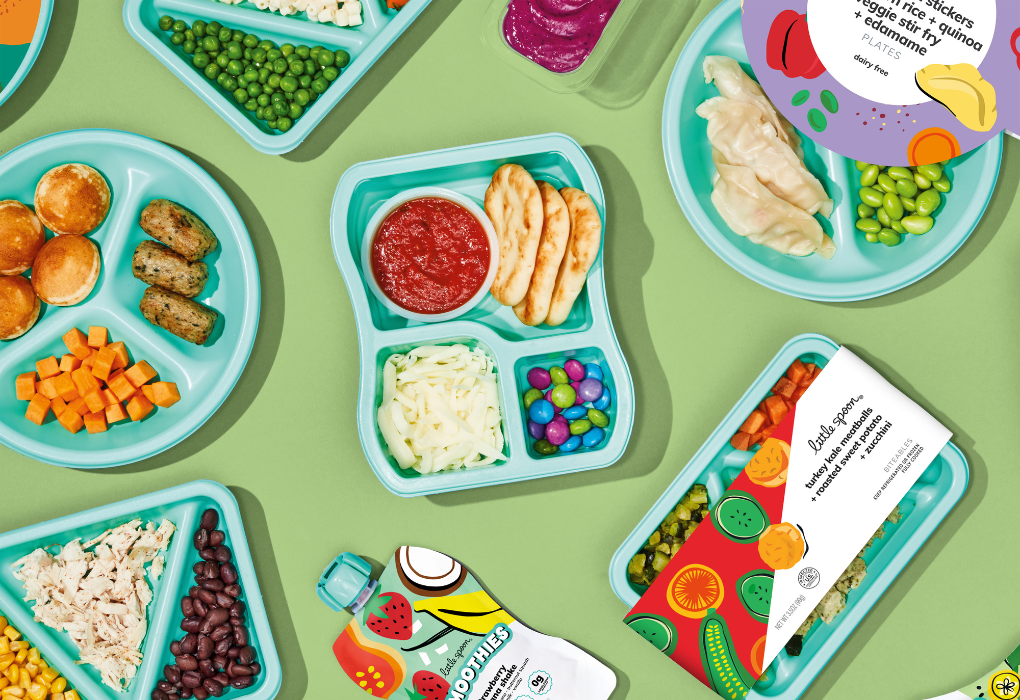School’s back in session and if you’re like me, you’re secretly doing mini cheers because hello, routine’s back in action! But with three different carpool schedules, endless grocery runs, laundry piles galore, plus a full-time job, the school year also comes with its fair share of chaos. And for me, a big piece of that chaos is packing school lunches.
As a dietitian and mom of three (a 6-year-old going on 16, a 4-year-old picky eater and a toddler), I know firsthand that packing lunches can feel like clocking into a second job. You’re trying to balance nutrient-rich foods with foods your kids will actually eat (and not toss), while also making sure these foods give them enough fuel to power through their busy day.
That’s why this year, I’m ditching the lunch-packing overwhelm and aiming to make this daily ritual quicker, easier and more sustainable. I’ve switched up my routine, and now I’m sharing it with you! Here are my tried-and-true shortcuts for nutritious lunches so you can pack, breathe and maybe even sip your (microwaved) coffee in peace.
Make a weekly menu.
Step one of surviving the lunch-packing grind is getting organized—and that starts with a weekly menu. It might feel a little extra at first, but trust me, you do not want to be scrambling every morning trying to remember what you packed yesterday, or worse, realizing you’re out of ingredients.
Creating a weekly menu will guide your grocery shopping and ensure that your child is getting a variety of different foods, which can be particularly helpful when they start complaining they’re “always getting the same thing”—sound familiar?
Here’s how to do it: at the start of the week, jot down the foods you’ll need. You can organize it by food groups (more on that below) and map it out to match the compartments in your bento box. Then, tack the plan to the fridge and review it with your kids. When they know what to expect, there are fewer surprises and a better chance they’ll actually eat what you pack.
Master the food formula.
Next up is getting your food groups in order. This is an important step because the right balance of food groups fuels activity, keeps little tummies satisfied and provides vitamins and minerals to help kids feel their best during a busy day of learning and play. Here’s the formula:
Protein
Protein gives kids the fuel to power through gym class and focus on math. It also helps them feel full, which is especially helpful if there’s a long stretch between lunch and snack time.
Lunch-friendly proteins include:
- Cheese sticks or slices
- Turkey slices
- Chicken nuggets (with hidden veggies!)
- Hard-boiled eggs
- Edamame
- Nut or seed butter
- Canned tuna
- Greek yogurt
- Cottage cheese
- Beans
Carbs on carbs
Carbohydrates are kids’ main source of energy—think running, climbing and nonstop imaginative play. But not all carbs are created equal, and the key difference between them is fiber. Complex carbohydrates are loaded with fiber, which keeps kids full and digestion running smoothly. Refined carbohydrates lack fiber and are found in white rice, white bread and white flours.
Kid-approved whole grains include:
- Whole wheat bread, tortilla or pita bread
- Whole grain crackers
- Whole wheat or legume pasta
- Brown rice
- Oatmeal
- Quinoa
- Whole grain cereal
- Granola with rolled oats
Fruits and vegetables
Fruits and veggies are packed with vitamins, minerals and fiber and they also make lunchboxes look fun and colorful. Ideally, you’d include both every day, but if that feels impossible (or you don’t have enough dedicated bento sections), rotate between the two so you cover your kids over the course of the week.
The goal is to get creative. Fresh produce is great, but you can also try:
- Unsweetened fruit or vegetable chips
- Freeze-dried fruit
- Dried fruits
- Pureed fruits and vegetables
I love keeping Little Spoon Smoothie pouches on hand because they include both fruits and vegetables, even some that kids might normally pass on, like golden beets or spinach. You can also add in veggies with Little Spoon plates, which have hidden produce in every bite, like Mac and Three Cheese with butternut squash and carrots, or Mini Turkey Kale Meatballs packed with kale and spinach.
Healthy fat
Growing kids need healthy fats and they provide calories to support growth and development. If your lunch already includes protein with some fat (like chicken or cheese) you don’t need to add extra. But for low-fat proteins like beans or edamame, consider adding an extra dose of fat, such as:
- Nut or seed butter (both a protein and fat)
- Tahini dip
- Avocado
- Pitted olives (slice in half lengthwise for kids under 4)
Once you’ve mastered this formula, it will become second nature. Grabbing and packing each component of the formula will be quick and effortless, almost like you don’t even have to think about it (goals!).
Consider ready-made options.
Even with the best-planned weekly menu and a fridge full of ingredients, some days are just a doozy. Maybe a late-night work call leaves you exhausted, or maybe you just need to give yourself a little grace because parenting is a full-time job too. Whatever the (valid) reason, I always keep a stash of nutritious, ready-to-go foods on hand. These no-prep foods save time, cut down on stress and honestly make the whole lunch-packing routine feel way more manageable.
Here are some of my favorites I keep stocked at all times:
- Whole milk yogurt cups or Little Spoon YoGos (whole milk Greek yogurt with probiotics and 4g protein!)
- Single-serve hummus and guacamole cups
- Little Spoon Lunchers (with 10g+ protein per meal!)
- Little Spoon Super Chicken Dippers or Mini Turkey Kale Meatballs
- Cottage cheese and fruit cups
- Mini carrots
- Raisin boxes
Bonus: You don’t even have to go out of your way to find ready-made foods. Select Little Spoon offerings (like their Super Chicken Dippers or Mini Turkey Kale Meatballs) are now available at Target. So while you’re stocking up on diapers, wipes and socks (why are socks always disappearing?), you can toss some healthy, ready-to-go lunch items in your cart, too. Even better, you can shop their full product line online and have it delivered straight to your doorstep. That’s one less errand and a little more time to spend with your family.
Don’t forget the snacks.
Packing a healthy lunch is important, but snacks are the glue that keeps the whole day together. Whether your child is in half-day or full-day school, one meal isn’t enough to fuel all their learning and playing. Depending on their schedule, kids may get one to three snack breaks—so let’s make them count.
The hack is to pair a carbohydrate (quick energy) with a protein or healthy fat (sustained energy and satiety) to keep blood sugar steady and avoid crashes.
Here are some snack pairings that check all the boxes:
- Apple and peanut butter
- Banana and almond butter
- Rice cakes and cheese
- Little Spoon Oat Bakes (3g protein per bar!)
- Clementine and a cheese stick
- Carrot sticks and guacamole
- Little Spoon Pizzalicious Veggie Loops with hummus
- Yogurt and granola
- Little Spoon YoGos pouch
At the end of the day, packing lunch doesn’t have to be a source of stress. With a little planning, and some ready-to-go options, you can create lunches that are nutritious and kid-approved, even when mornings are hectic.
Remember, their lunchbox doesn’t have to be perfect every day. Some days you’ll nail the formula and other days you might lean on ready-made options, giving you a few extra minutes of snooze time (double win!).
Here’s to calmer mornings, happier kids and lunches that fuel both their bodies and your sanity. You’ve got this.



